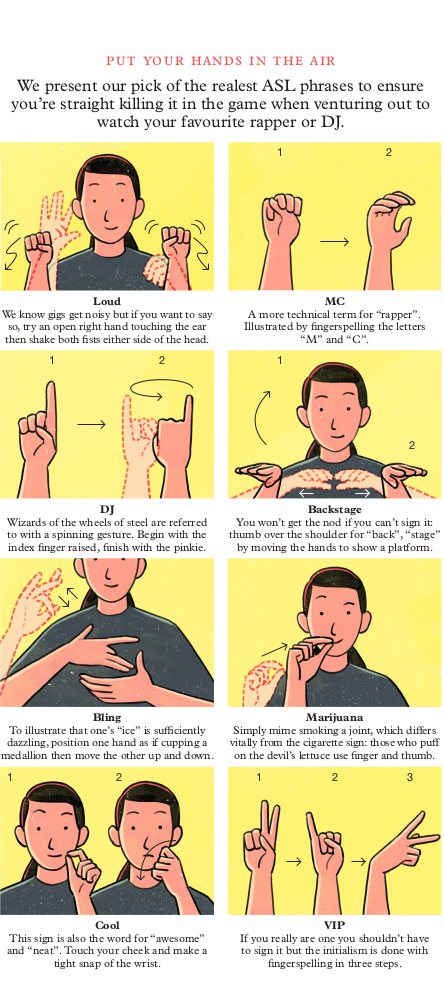Monocle, May 2019
Like any language, signing changes with the times – and that incorporates updates to include the latest obscenities and drug references. Monocle put its hands up for a lesson in lyrics at a Texas gig.
It’s Saturday night in downtown San Antonio, Texas, and the Aztec Theater, a venue dating back to 1926, is packed. Gigantic columns frame the stage on both sides and from the top, Mesoamerican-style head sculptures glare down at the masses as the place reverberates. At the foot of one of the columns, lit up by a spotlight, Amber Galloway-Gallego is working the crowd. With her psychedelic-skunk shock of pink hair, she pivots from side to side in sync with the beat and air-scratches on invisible decks.
Galloway-Gallego and her two colleagues, Kelly Kurdi and Shelby Mitchusson, are charged with interpreting the hip-hop lyrics of Cypress Hill (they of “Insane in the Brain” fame) into sign language – with all the cap-popping, bong-smoking imagery that goes with it.
In the direct eyeline of Galloway-Gallego and her team are several ticket holders from the deaf and hard-of-hearing community, many of them attending a music concert for the first time. Each interpreter has a distinct style; Mitchusson has something of the robot dance to her, while Kurdi is more loose-limbed. It’s a mentally and physically demanding task, involving not just “feeling” the music with the requisite gestures for shimmering basslines, frantic guitar strumming and volleys of drumkit percussion but also keeping up with the rapid-fire, profanity-riven lyrics. The speed and dexterity are impressive, even for those who don’t comprehend the intricacies of American Sign Language (ASL), meaning each interpreter cedes the floor to another colleague after a few songs, to give themselves a rest.
After the show, gathered in the main lobby with the deaf concert-goers, the three interpreters explain ASL. “There are set rules with sign language – parameters,” says Kurdi. “But the beautiful thing is that each interpreter, or each deaf person, can be very creative in the way they express their message – especially with music.” Simply put, sign language is divided into “iconic” signs that in some way mimic or reproduce an element associated with what is being described (a fin movement to represent a shark, for example, or a branch for a tree), while the abstract signs have no direct visual link to what they are describing.
All three of the interpreters, who are hearing or hard of hearing, had formative experiences with deaf people when they were younger that made them want to learn ASL. As with any living language, ASL is constantly changing as slang or ways of signing get picked up by one part of the country before spreading elsewhere – and that’s before mentioning regional differences. Which means Galloway-Gallego and her crew are always checking with deaf friends that they’re “on point” with their signing. “We constantly have to train ourselves and think about ways to sign. We’re constantly evolving.”
The deaf concert-goers have clearly had a great time – one person is a little tipsy and wants to hug everyone. Meanwhile, 25-year-old Izabel Stepanova, originally from Russia, is ecstatic because she got to meet Galloway-Gallego, something of a celebrity in the deaf community through her online music videos, in which she signs to artists ranging from Snoop Dogg to the Red Hot Chili Peppers. “I’m imagining if I came here and I didn’t have an interpreter; I wouldn’t have any idea of what the musicians were talking about,” says Stepanova in sign language, as Kurdi interprets into spoken English. “But now I know that there were dirty words and they were talking about weed. I feel like I understood everything rather than just feeling vibrations and bass.” As for the interpreters, one man comes up to them after the show and asks if they are from Tennessee. The reason? “Because you’re the only tens I see in the room.”